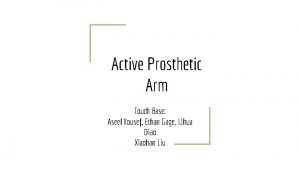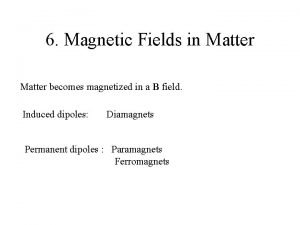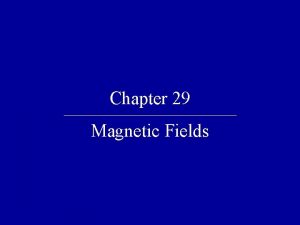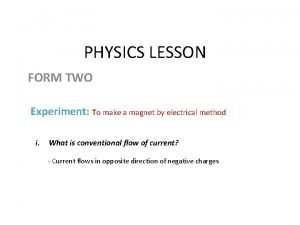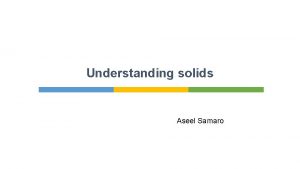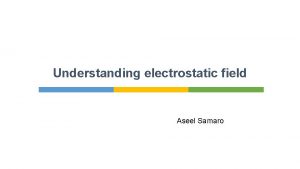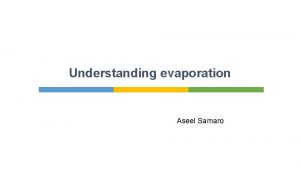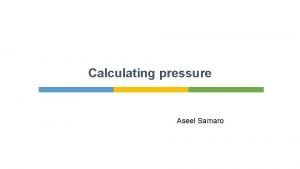Understanding magnetic fields Aseel Samaro Introduction Magnetic materials



















- Slides: 19

Understanding magnetic fields Aseel Samaro

Introduction § Magnetic materials in the region around a magnet experience a magnetic force. § The Earth behaves as a gigantic magnet that attracts particles from outer space towards the North and South Poles. § As these particles enter the Earth’s atmosphere they cause an amazing natural light display.

The Aurora Borealis over Iceland

Magnetic fields § A magnetic field is the space around a magnet where its magnetic field works. § Within the field, magnetic materials such as iron are attracted. § Other magnets can be attracted if unlike poles are close enough or repelled if like poles are close enough.

§ Sprinkling iron filings around a magnet shows the magnetic field. § Each of the filings becomes a tiny magnet that lines up with the field, because of magnetic forces acting on it. § The arrangement of the filings shows the magnetic field lines. § The closer the lines of magnetic force are to each other, the higher the strength of the magnetic field. § The direction of the field lines is the direction in which a magnetic north pole would move if placed in the field – from north (N) towards south (S). This is the way a compass would point.

The iron filings show the shape and strength of the magnetic field.

What does the pattern of iron filings around a magnet show? What does it not show? Why are the lines of force closer together near the magnet poles? Tiny fragments of substances other than iron could be used to show the force lines in a magnetic field. Choose which ones would work from this list: scraps of paper, steel, pepper, plastic, sawdust, nickel, house dust, copper, carbon.

What does the pattern of iron filings around a magnet show? What does it not show? The shape and the relative strength of the magnetic field; they do not show the direction of the magnetic force Why are the lines of force closer together near the magnet poles? The magnetic field is stronger near the poles. Tiny fragments of substances other than iron could be used to show the force lines in a magnetic field. Choose which ones would work from this list: scraps of paper, steel, pepper, plastic, sawdust, nickel, house dust, copper, carbon. steel; nickel

The earth’s magnetic field § The Earth’s core contains materials that are rich in iron. § Around a solid inner core is a molten outer core. § Scientists believe that currents within the molten core create a magnetic field as they flow around.

§ Two well known effects of the Earth’s magnetic field are: 1. Magnets line up in a N to S direction, if they are free to turn. This is how a compass works. 2. The Aurora Borealis (Northern Lights). Charged particles entering Earth’s atmosphere attracted to the magnetic poles. As they collide with the gas particles in the atmosphere an amazing natural light display is created.

§ The Earth also has a gravitational field, which is the region around the Earth where the force of gravity acts. § The gravitational field attracts all masses, whereas only particular materials are affected by the magnetic field. § You will learn more about the Earth’s magnetic field in Chapter 6.

The Earth’s magnetic field. The geographic and magnetic poles do not exactly coincide

Why does the Earth have a magnetic field around it? Describe similarities and differences between magnetism and gravity. How can evidence be collected to find out whether other planets have magnetic fields?

Why does the Earth have a magnetic field around it? The outer core contains liquid iron-rich materials which flow; electric currents are created and produce a magnetic field. Describe similarities and differences between magnetism and gravity. Both magnetism and gravity produce a force; which declines in strength with distance. Gravity is stronger; acts over a greater distance; is always an attractive force; and it acts on all objects How can evidence be collected to find out whether other planets have magnetic fields? Observe the behaviour of a compass on space probes that fly near to other planets

The magnetic field model § Scientists often use models to try to represent things that are hard to see or understand. § A model can be a simplified version, a description or a picture. § This figure shows a model that represents the Earth’s magnetic field. § It is useful because it helps us to understand something we cannot see. § Many models do not represent reality exactly and scientists need to be aware of the weaknesses of the models they use.

Explain, using examples, why scientists use models. Evaluate the Figure 2. 5. 3 c as a model of Earth’s magnetism. What are its strengths and weaknesses?

Explain, using examples, why scientists use models. Models make it easier to visualise and understand things. For example: the particle model for states of matter; a scale model of the Solar System; various models for the behaviour of electric currents. Evaluate the Figure 2. 5. 3 c as a model of Earth’s magnetism. What are its strengths and weaknesses?

Did you know…? § You can magnetise a piece of steel by stroking it many times in the same direction with a magnet. § When a magnet is heated or hammered its magnetism becomes weaker.

Thank you
 How to identify pure aseel
How to identify pure aseel Aseel yousef
Aseel yousef Red fields to green fields
Red fields to green fields Lab samaro
Lab samaro Why must guard cells come in pairs
Why must guard cells come in pairs Gc 101
Gc 101 Samaro property
Samaro property Learning: module 26: magnetic forces and fields
Learning: module 26: magnetic forces and fields Magnets and magnetic fields lesson 1 answer key
Magnets and magnetic fields lesson 1 answer key Magnetic field in matter
Magnetic field in matter Magnetic fields quick
Magnetic fields quick Electric currents and magnetic fields
Electric currents and magnetic fields Visualizing magnetic field
Visualizing magnetic field Confidential
Confidential Magnetic flux formula with current
Magnetic flux formula with current Magnetic moment and magnetic field relation
Magnetic moment and magnetic field relation Force on charged particle
Force on charged particle Magnetic materials used in electrical machines
Magnetic materials used in electrical machines Distinguish between magnetic and nonmagnetic materials
Distinguish between magnetic and nonmagnetic materials Electric field and magnetic field difference
Electric field and magnetic field difference

